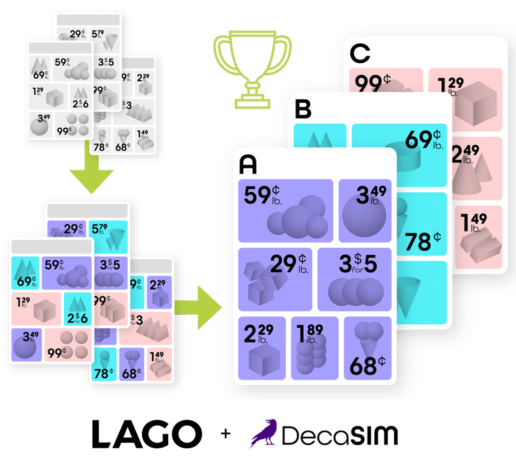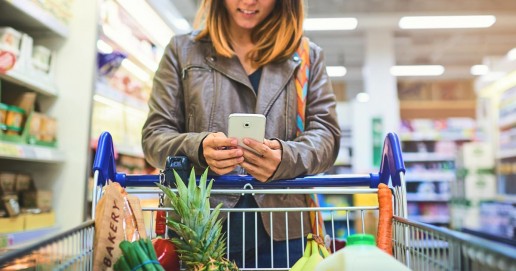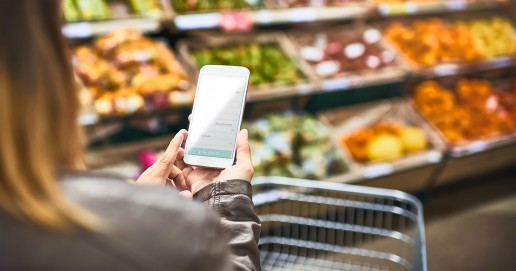Inside the Hypertrade & Comosoft Strategic Alliance: A Blueprint for Retail Excellence
Inside the Hypertrade & Comosoft Strategic Alliance: A Blueprint for Retail Excellence
Interview with Frederic Etienbled (CEO of Hypertrade) and Peter Jozefiak (Managing Director of Comosoft)
In this insightful interview, we connect with Frederic Etienbled and Peter Jozefiak, the driving forces behind Hypertrade and Comosoft, to explore their strategic partnership. Hypertrade, celebrated for its comprehensive retail solutions, and Comosoft, a leader in multichannel marketing software, are joining forces to innovate the retail sector. Their collaboration aims to introduce integrated solutions that cater to the evolving demands of retailers around the globe, signaling a new chapter in retail excellence.

Frederic Etienbled
Hypertrade

Peter Jozefiak
Comosoft GmbH
Unveiling the Vision and Objectives
Can you both describe the vision behind the Hypertrade and Comosoft partnership?
P.J.: Comosoft and Hypertrade complement each other perfectly with their products and create value along the entire value chain in the retail sector. Hypertrade expands the service portfolio of Comosoft and the software product LAGO to include the data analysis part. LAGO as a multi-channel production software stands for the efficient production of advertising in all marketing channels. Hypertrade complements the efficiency of LAGO by qualifying product data.
F.E.: Despite doubling down on creating captivating promotions, Hypertrade clients often struggle with streamlining production. LAGO bridges this gap by seamlessly aligning promotion planning and strategies with flawless omnichannel production and communication. Our partnership empowers them to automate the end-to-end promotion process, boosting customer experience while reducing costs.
What are the main goals you aim to achieve together?
P.J.: The result of the partnership is very easy to describe! With the solutions from Hypertrade and Comosoft, relevant products are made available to end customers at the right time and with minimal production effort in a wide variety of marketing channels. Time savings of 50% and a sales increase of 10% can be realized in retail with these solutions.
F.E.: In addition to what Peter shared, the partnership between Comosoft and Hypertrade will empower several retailers to plan, work and engage their customers “like the big guys”, opening for them a new horizon of possibilities and growth.
Highlighting Individual Expertise and Synergy
How do Hypertrade’s solutions enhance Comosoft’s omnichannel offerings?
F.E.: Hypertrade simplifies, automates, and optimizes retail processes to ensure a consistently exceptional customer experience. With same focus as Comosoft on data management and data quality, our machine learning and AI-powered solutions go beyond suggesting the right products: they measure performance with precision, continuously refine selections, and integrate shopper behavior changes. This is where LAGO’s technology comes in – it seamlessly translates these optimized offers across all marketing channels.
In what ways do Comosoft’s omnichannel capabilities enrich Hypertrade’s retail solutions?
P.J.: With Hypertrade’s evaluation of purchasing behavior, the data in LAGO’s PIM app can be enriched with sales-promoting texts and USPs. The LAGO DAM links the product data records with the image data and is transferred to the respective marketing channels via the LAGO planning module. The central data management ensures the consistency and synchronization of the product data in the various marketing channels. The decisive factor here is that Hypertrade’s data analysis means that the products are not assigned to the marketing channels based on a gut feeling but are the result of a sales evaluation.
Addressing Challenges with Success Stories
What challenges in retail are you aiming to solve with this partnership?
P.J.: Retailers almost always have the same challenge. High production costs in advertising production, reacting quickly to changes in products, prices and availability, logistics and procurement, as well as the storage of products. The solutions from Hypertrade and Comosoft meet these challenges.
F.E.: In today’s fast-paced market, retailers need agile teams that can make quick decisions while addressing diverse customer needs. Comosoft and Hypertrade provide solutions that empower retailers to meet these very challenges.
Looking Forward: Innovations and Future Prospects
With the retail landscape constantly evolving, how does your partnership offer a competitive edge to brick-and-mortar retailers?
P.J.: The demands on the retail sector are indeed changing from year to year. Nevertheless, the focus remains on retail customers. Knowing what the customer’s product preferences are, which price segment the customer is in, which marketing channels the customer wants product information in or simply when the customer prefers to shop helps retailers to match the product range with the customer’s preferences.
F.E.: Throughout the history of commerce, understanding customer needs has been a critical factor in a merchant’s success. This focus on customer-centricity is amplified by the Comosoft and Hypertrade partnership, which translates complex data into actionable insights, making it even more relevant for businesses today and tomorrow.
What future developments can clients expect from this partnership?
F.E.: The increasing power of technology often comes with growing complexity. Comosoft and Hypertrade share a vision to cut through that complexity, prioritizing user-friendliness. Flawless execution and time-saving features are hallmarks of our progress. Ultimately, our partnership thrives on making life easier for retailers and marketers, while continuously enhancing their customers’ shopping experiences.
Hypertrade excels in automating category management, providing businesses with cutting-edge tools to enhance product visibility and sales performance. The collaboration with Hypertrade is designed to unite our strengths, delivering an all-encompassing solution that integrates promotion workflows, category management, and CRM seamlessly for retailers and agencies.

Comosoft specializes in streamlining promotion workflows across diverse channels, empowering retailers to optimize their marketing efforts by automating the production of complex print and digital catalogs, flyers, and circulars. The collaboration with Comosoft aims to combine our strengths to offer a comprehensive solution seamlessly integrating promotion workflows, category management for retailers and agencies.
4 Ways to Improve the Retail Customer Experience
4 Ways to Improve the Retail Customer Experience
To make the customer experience central to their marketing strategy, retailers must thrive in offline (print) and online digital channels.
The retail customer experience is not an easily definable event – or even a series of events. It’s a complex relationship, not a checklist of dos and don’ts. And, like all relationships, it takes time and effort to develop. In recent years, it has become more challenging. Since the emergence of e-commerce and smart devices, amplified by crises like the pandemic, today’s customers insist on a “shopping anywhere” world. Retailers have no choice but to meet them where they are. What was once a relatively stable environment for marketing and advertising directors is now more like the 2022 hit movie Everything Everywhere All at Once.
One of the critical elements to coping in this environment is the retailer’s ability to provide consistent messaging across a seemingly infinite number of platforms. Print-based marketing and advertising haven’t declined but have changed, increasing complexity and customization. And as online channels multiply, they, too, demand a flood of consistent messaging and product details. It seems overwhelming, but there are ways that retail merchandising planners and their IT manager partners can control that flow and improve the overall customer experience.
1. Go Beyond the Screen
The hybrid shopping experience has become a retail fact of life. Customers with smartphones frequently browse in brick-and-mortar stores, only to price check and even purchase the product they like on Amazon. But the real problem is not Amazon, per se. It’s that the brick-and-mortar chains’ smartphone apps are not as agile as those of their online rivals. Special offers and incentives from the print catalog or flyer are not reflected in the mobile app, and the customer’s experience finding and buying products in person and online is too often separate.
This need not be the case. As detailed in a recent case study, home improvement giant Lowe’s achieved remarkable results in multichannel marketing for its 2,000+ locations. They did so by deploying Comosoft’s LAGO system to integrate the company’s product information management (PIM), digital asset management (DAM), and other data systems with its marketing production hubs. The system allowed their merchandising planners to easily create customized versions of their printed materials and export the same offers and incentives to Lowe’s mobile app, which customers could use to locate specific products in the store.
2. Consistency and Customization
The bane of complex, multichannel marketing is the overwhelming sea of data that describes each product. With so much data per product, even a single promotion can involve intensive (and costly) manual efforts to ensure everything is correct. The LAGO system automatically pulls all the related product data from PIM, DAM, and other systems to reduce overhead and consistently promote the right products for a particular region. It also allows for regional variations in print and interactive digital publishing applications.
All this activity happens behind the scenes, of course. The shopper sees a consistent customer experience of the retail brand across multiple touchpoints.
3. Work With Emerging Technology and AI
The modern customer experience also includes a remarkable degree of personalization, allowing the retailer to tailor its promotions to the needs and buying behavior of demographic or regional groups—even down to the individual level. But all that “magic” is based on the wise and responsible use of big data.
By definition, retailers have access to enormous volumes of data, including product data from the original manufacturers (stored in PIM, DAM, and other repositories) and transactional and feedback information from individual customers. Putting that data to work is the real challenge. One way of doing so is with LAGO’s Direct Individualized Marketing (DIM) module, which matches known customer preferences with detailed product data to create personalized, one-to-one communication via print and digital channels.
Of course, discussing big data would only be complete with exploring the possibilities inherent in AI. Comosoft and DecaSIM revealed in a recent case study that AI tools can identify purchasing patterns, such as customer preferences for related products. When paired with LAGO’s ability to manage promotional campaigns, the AI tool enabled merchandising planners to make better product selections, significantly boosting store revenue.
4. Focus On the Product Experience
At the end of the day, a good customer experience depends on individuals finding the right product for them, being happy with their purchase, and developing a sense of loyalty to the retailer who made that possible. Over time, that relationship will lead to repeat purchases and increased word-of-mouth referrals.
However, replicating such positive, brand-building experiences for thousands of customers and millions of products means that the retailer must have high data agility. Their advertising and marketing teams must expertly juggle vast amounts of data, synchronized across multiple systems, customized to the regional, demographic, and even individual level, and delivered across various print and digital channels. They must also do so affordably and under enormous time constraints.
That level of data agility is possible only with systems like Comosoft LAGO.
Find out more about Comosoft LAGO’s unique, multichannel approach. Or book a demo to see for yourself.
Putting AI To Work: How Retailers Can Find More “Diamonds In the Rough”
Putting AI To Work: How Retailers Can Find More “Diamonds In the Rough”
Last month, we discovered that artificial intelligence, far from being a threat to retail marketing teams, is, in fact, an essential team player. The early results of using DecaSIM’s AI tools in conjunction with Comosoft LAGO showed that the two systems complement one another, each providing unique benefits for retail advertising and marketing directors. In this month’s article, we look at the two companies’ plans and what they mean for retailers of every kind.
Test overview
Recently, we tested the effect of using AI to optimize product selection in a regional grocery chain’s marketing campaigns. As reported in the published case study, the results were truly remarkable.
In the test, the regional grocery chain selected a 104-store region (out of over 300 stores) and, using Comosoft LAGO, created a specific version of its weekly ad circular to optimize during the test period. Each week’s promotional plan was run through DecaSIM’s AI optimizer during the test period. The analysis results were used to select which items to feature on each page of the circular. Compared with the sixty-five other stores chosen as a control group, the AI-assisted promotions increased sales by over $4,000 per store per week.
As AI improves profitability in the retail grocery sector, other retail chains can expect similar or even better results.
The importance of foot traffic
DecaSIM co-founder Doug Edmonds described a crucial factor in the grocery retail industry that is common to all retailers.
“All retail is trying to drive foot traffic, often with price as an incentive,” he said. “Whether you’re a grocery business or a home improvement retailer, if you depend solely on infrequent shoppers, you won’t survive.”
Edmonds continued, “Every retailer has a ‘core shopper group’ they must satisfy. Whether they’re buying tomatoes or socket wrenches doesn’t matter; their product preferences, shopping habits, and price sensitivity matter. Using AI to learn those things gives all retailers an edge. It will help them sell more to that core group. It will also grow that regular foot traffic over the long term.”
Comosoft’s US President Randy Evans noted that the grocery industry was only the beginning. “Grocery retailers have been using LAGO for years,” he said, “especially those chains that require regional versions of their weekly flyers and mobile shopping apps. We’ve always made it easy to prioritize offers, pull data from various sources, and streamline the design process across multiple stores. A fast turnaround is essential. But with DecaSIM’s AI tools, grocery advertising and marketing directors can know what products to prioritize in each campaign. It’s a slam dunk for our grocery clients, but our other retail clients can do the same thing.”
Diamonds in the rough
This use of artificial intelligence solves a problem facing all retailers—finding meaningful information in a mountain of product data. With thousands or even millions of individual products from many sources, retailers’ databases today are jammed with data related to each SKU. Typically, these reside in product information management (PIM), digital asset management (DAM), inventory, pricing, and marketing management databases. Too often, they are poorly integrated, forcing marketing heads and designers alike to hunt for detailed information for each product. This process is both time-consuming and prone to costly errors. With limited time and a seemingly unlimited array of print and digital channels, picking which products to feature involves a combination of intuition and guesswork.
LAGO’s unique ability to unify the PIM, DAM, and other data sources is part of the solution, creating a collaborative workflow, including both the design and the review and approval process. But even with a data-optimised, multichannel workflow, it still falls to the advertising and marketing directors to make priority decisions during the planning process. And even experienced planners may miss promotional opportunities amidst all that data.
Enter the AI part of the equation. DecaSIM’s artificial intelligence tools take data from each previous LAGO-driven campaign, identify patterns of core shoppers’ product preferences, and derive inferences and purchasing patterns, faster and with greater accuracy from that mountain of data. It then returns the results to LAGO, in effect “supercharging” the metadata used to create multiple versioned campaigns. AI can, in effect, find marketing diamonds amid raw data that would take humans too long to process.
Roadmap to marketing success
Comosoft Product Manager Steve May outlined what this could mean for future versions of LAGO.
“Today, campaign planners use our whiteboarding feature to create offers and product groupings that make the most sense based on margin, availability, and success in previous campaigns,” he said. “LAGO could add AI-generated weighted scores, relationships to other products, seasonal or regional patterns, and other useful indicators to featured products. They would still choose which ones to use but would be more informed marketing choices.”
By adding AI to LAGO, sales and marketing campaigns could be planned and executed at scale, with an objective knowledge of their sales potential. Far from taking jobs away from retail marketing professionals, AI would serve as a highly efficient research assistant, gathering objectively valuable information that the planner would use to create effective campaigns.
“Today, people are nervous about AI and what it will do to their careers,” Evans said. “In the case of retail marketing, it’s pretty obvious that AI is an ally in our data-intensive world.”
Can AI help retail?
Can AI help retail? A no-nonsense strategy for success in the AI revolution
A mere eleven months ago, OpenAI launched the public version of its AI-based, large language model, ChatGPT. In that short time, the noise surrounding AI has dominated the media, boardroom conversations, and almost every social gathering on the planet. Retail advertising and marketing directors everywhere are inundated with questions. “What are we doing about artificial intelligence – and how will we survive without it?”
Thankfully, Comosoft and its AI development partner, DecaSIM, have a practical answer. They now offer a clear path for retailers searching for real-world AI solutions, relieving the pain of turning vast amounts of complex data into meaningful, more cost-effective marketing campaigns. In a recent case study, a leading regional grocer implemented a live test of Comosoft’s marketing automation system, LAGO, in combination with DecaSIM’s AI-based data analysis tools, generating positive results from week one. By optimising which promotions to feature in its advertising and creating more customer engagement, the company demonstrated increased weekly sales and an eight percent increase in EBITDA profitability.
Artificial intelligence for the rest of us
Much public anxiety over AI stems from common misperceptions about the technology. ChatGPT and other “generative” AI systems often look for patterns in vast amounts of unstructured data – meaning there are no preexisting identification tags or metadata to help us sort or classify them. The Comosoft/DecaSIM AI model is based on a smaller set of structured data, such as the known purchase history of specific products, prices, and seasonal buying patterns. The AI tool uses the data to solve equations to create new (and precious) metadata describing shoppers’ behavior and preferences about specific products.
In other words, the AI is finding meaningful inferences from the data based partly on the domain knowledge of advertising and marketing professionals. It does so with volumes of data that, while not as vast as the trillions of data parameters required by generative AI systems like ChatGPT are still too large for humans to analyse without help.
All this puts the Comosoft/DecaSIM approach in the category sometimes known as “Narrow AI,” or artificial intelligence designed to perform specific tasks. This differs from purportedly self-aware, artificial general intelligence or AGI, which is still hypothetical at best. However, since simplified tasks are critical to retail success, advertising and marketing directors have little to fear and much to gain. The belief that AI is taking over from humans is offset by a growing awareness that AI can be a critical part of any retail marketing team.
During the testing process with retailers, DecaSIM co-founder Chris Antipa noted that advertising and marketing departments are finding their work enhanced, not threatened.
“There’s always this natural pushback, with people saying, ‘Hey, computers are coming for my job.’ But as time passes, they begin to understand what the AI is doing for them and talk about the platform as a teammate. They even joke that they should give it a nickname.”
Putting AI to work
The combination of DecaSIM’s AI tools and Comosoft LAGO can only be described as a high-impact data solution. LAGO already automates various vital functions for retailers, including integration of campaign planning, numerous data sources, and streamlined production of print and digital campaigns – including multiple regional versions of each catalog, flyer, or digital equivalent. Using AI elevates that process even further. Historically, structured data from LAGO and other sources are fed to the DecaSIM system, deriving meaningful shopper habits and preferences for specific products and product categories. This enhanced metadata is fed back into LAGO, providing an objective basis for promoting particular products at specific locations and times of the year.
The results have been remarkable. Co-founder Doug Edmonds recounted the response of one retail executive, who said the DecaSIM/LAGO combination “made every ad like a holiday ad,” thanks to the system’s ability to anticipate shoppers’ preferences and product attributes. “The data we utilize contain context and meaning hidden to most of the retail world,” Edmonds continued. “AI uses those data to define that context and meaning, rate its importance, and add all that to the metadata for each product and category.”
The LAGO approach, which integrates marketing-relevant data from product information management (PIM), digital asset management (DAM), and other sources, is ideally suited to optimise the new DecaSIM data. “Traditionally, more than half of our implementations start with some rich data feed,” said Comosoft Product Manager Steve May. “Typically, this is a collection of product SKUs, digital assets, and offers. With DecaSIM, the data are enhanced before we even get it.”
This is especially important to advertising and marketing directors at the planning stage of a campaign. LAGO’s whiteboarding capability already gives them an overview of which products to feature prominently based on criteria such as regional availability, profit margin, and sales history. With the addition of DecaSIM data, they also can have reliable indicators of what shoppers will more likely purchase, including their preferences for related or alternative products.
“LAGO and DecaSIM are both ‘painkillers’ for retail advertising and marketing professionals,” said Comosoft US President Randy Evans. “One stops the pain of integrating PIM, DAM, and other data to execute campaigns at scale. The other removes the guesswork of which products are more likely to sell.”
The future of AI in retail marketing
The success of this approach is not limited to the grocery market. Retailers depend heavily on regular foot traffic and a known population of frequent shoppers – a dimension that fits everyone from home improvement and hardware retail chains to fashion and lifestyle brands. Knowing objectively what shoppers want and advertising accordingly is a holy grail for all retail marketers – one that DecaSIM’s AI can find and LAGO can implement, even down to the local level and on multiple print and digital platforms.
The two companies are actively engaged in combining and expanding these capabilities shortly. Some of these enhancements will be the subject of next month’s article.
Optimising promo selection with AI to increase profit
Optimising promo selection with AI to increase profit
Discover how AI can enable grocery retailers to plan promotions that consider seasonality, unique pricing, and product data to engage customers, increase sales, and grow profits.
Add Intelligence & Harvest Profit
Recent advances in artificial intelligence (AI) brought to market by Chat-GPT and GPT-3 is a clear signal that AI is a viable technology for retail marketing departments. Integrated with Comosoft LAGO, the AI-based DecaSIM promotion ranking tool adds an additional layer of intelligence to the existing planning process, adding measurably to the impact of the weekly ad and on store profitability.
Implementing DecaSIM’s AI solution is easy. Our technology integrates seamlessly with existing processes and infrastructure. To demonstrate this, a leading regional grocer implemented a live test and generated positive returns from week one. By optimizing which promos to feature in its advertising, their customers were more engaged with the offers, which increased weekly sales and grew profits (EBITDA) by 8%.
Customise promos on undiscovered shopping patterns
Retail price promotions serve as a catalyst for customer engagement, loyalty rewards, and shaping purchasing behaviors. However, as promotional strategies become more intricate, the challenge lies in leveraging these discounts to drive incremental shopping trips.
Customer behavior is complex and in the realm of promotions there are many potential unintended consequences. For example, different promotions often cannibalize one another by appealing to the same audience. The net effect can be a zero increase in customer engagement. In today’s inflationary environment, this can result in a missed opportunity to increase shopping trips from the growing audience of value-conscious shoppers.
Comosoft LAGO and DecaSIM work together leveraging DecaSIM’s advanced retail AI to create a predictive model that simulates the response of your shoppers to different promotional strategies. Through this innovative AI technology, we can discern the most potent promotions for drawing in customers. Our integrated solution adeptly pinpoints the promotions that resonate most with your price-conscious shoppers, fostering heightened engagement, increased sales, and amplified profits for our valued retail partners.
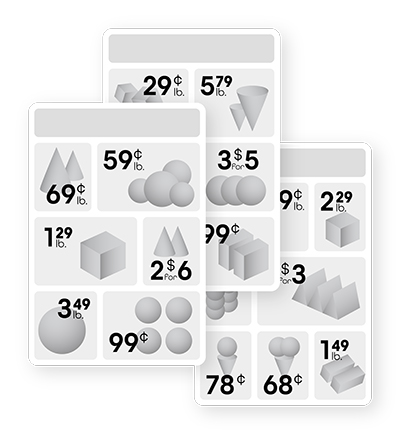
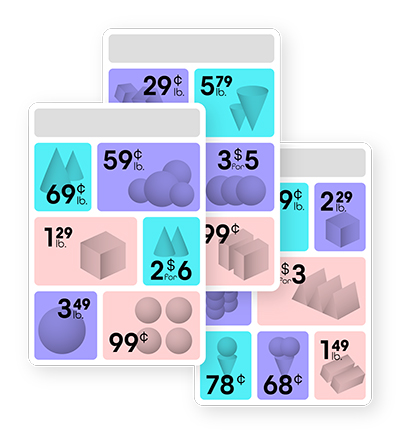
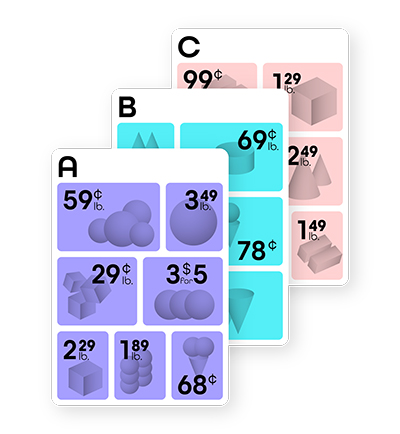
Putting theory into practice
A 300+ store regional grocer selected a region and, using the Comosoft LAGO system, created a specific version of its weekly ad circular to optimize during a ten-week test period. Each upcoming week‘s promotional plan was run through the DecaSIM optimizer during the test. The results of this analysis were then used to select which items to feature on each page of the circular.
The test region consisted of 104 stores. An additional control region was created with 65 stores. To evaluate the intervention, the percentage of shoppers who engaged with the promos featured in the weekly circular was measured in the test region stores, and these results were compared to those from the control region stores. Total store sales in the test and control region stores were monitored carefully for changes.
Results show increased performance on all measures
Conducting these tests, the retailer established a set of measures to evaluate the performance of the recommendations, increased engagement with promos, impact on total store sales, and store profits. On every metric, the results showed a positive increase versus the control.
Download the full case study here!
Fill out the contact form and receive an e-mail with the link to download the case study. If you don’t receive an e-mail from us, please check your spam folder.
Growing e-commerce with print? Yes, please.
Growing e-commerce with print?
Yes, please.
Yes, please.
Life without e-commerce is inconceivable today. Even in a retail store or shopping mall, it’s common to reach for our phones to compare prices or check on the availability of something in a different color or size. Brick-and-mortar store managers may resent it, but mobile e-commerce is here to stay.
But it’s also no surprise that retailers continue evolving their marketing strategies, supporting a consistent customer experience across every channel. Both brand identity and product promotion details must be consistent, regardless of the device or medium is used. That requirement is essential to marketing and advertising directors – and the production and creative managers who get the job done – whenever they coordinate retail campaigns in their print and mobile shopping iterations.
Faced with the need to optimize marketing spending, retailers are expanding and enhancing their traditional print advertising strategy. Weekly circulars and product catalogs are no longer just standalone elements. They now must be totally in sync with their mobile shopping app counterparts. All the elements of a featured product – images, brand elements, even color and size choices – must be consistent across every channel and customer experience, even down to the local store level.
Even more critical, the printed elements of a campaign must also serve as a “launching pad” for the mobile e-commerce experience. Catalogs, circulars, and flyers can no longer be merely informative and persuasive displays. They must also make it easy for customers to order products on the spot. Of course, the easiest way to do that is to print a QR Code next to the featured product, but doing so efficiently can be challenging.
It’s all in the data
QR Codes can be generated easily for each product SKU and then stored, like any other image, in a Digital Asset Management or DAM system. Each code can take the catalog or flyer reader directly to the retailer’s e-commerce ordering page for that specific product, dramatically shortening the sales cycle and providing immediate feedback on the print campaign’s effectiveness.
But while the print-to-e-commerce-purchase cycle is easy to understand, it can be difficult to implement on a large scale. With dozens or hundreds of SKUs in every print marketing campaign, plus the need for multiple regional versions of each printed piece, it takes a lot of work to keep all that DAM and Product Information Management (PIM) data straight. It’s also a challenge for designers to manually assemble all that data and imagery into a single ad—not to mention a catalog or flyer featuring multiple products.
Fortunately, the LAGO system was designed to do precisely that. Using an InDesign plugin, designers can easily and automatically assemble all the PIM and DAM elements related to any SKU in the retailer’s marketing campaign, focusing their time on designing the catalog or flyer—and not hunting for all the pieces. One of those “pieces” in the DAM system can easily be the QR Code for that SKU. Thus, the designer doesn’t have to test or worry about whether the QR Code is correct. They focus on design.
LAGO can do even more than that, of course. For example, if a retailer needs to create different versions of a piece with regional price or product variations, doing so is simple and effective. And because LAGO’s digital output supports versioned pages, including product hotspots and QR Codes, even complex, multi-region retailers can easily transition their print campaigns to digital, creating content for multiple channels with data that increasingly resides in the cloud.
On beyond print
Once a print layout is created in LAGO – for a single catalog or multiple regional versions—the journey is not over. All the related PIM and DAM data can also populate e-commerce websites and mobile shopping apps. During the layout process, designers can designate product hotspots, which are not used in the printed output, naturally, which allow the online output to contain live links to the e-commerce ordering portal, to use just one example.
Product hotspots have many other uses, including triggering multiple image galleries, special offer overlays, size and color variations, alternate text descriptions, and more. These elements have the advantage of being connected to a product’s PIM and DAM data, so the designer need not spend hours figuring out how the online version will behave.
The necessary PIM, DAM, and other data to required accomplish these tasks are increasingly located not in local servers but in the cloud. This is especially true for large, multi-region retailers but is also becoming the norm for marketing departments in every industry. Fortunately, LAGO and its components can easily be cloud-based, offering IT departments increased flexibility and scalability.
Once the main layout is created, LAGO can export the results to multiple formats, each appropriate to the required print or online channel. In addition, it can automatically generate XML and JPEG/PDF for selected pages based on the desired multichannel output workflow. With so many channels in constant need of consistent, well-formed content, LAGO has proven to be a reliable workhorse for retail marketing and advertising operations.
Finally, no discussion of multichannel marketing would be complete without mentioning the growing arena of dedicated retail shopping apps. Like all other online channels, shopping apps need to be constantly updated with the latest product information and marketing campaigns. Fortunately, LAGO can export all campaign data directly, including regional variations, to populate the retailer’s own website or mobile app, creating product location and pricing aids based on LAGO’s versioning capability. One such retailer, home improvement chain Lowe’s, used the LAGO system to create its multi-version printed flyers and, by exporting the resulting campaign data to third-party developer FLIPP, allowed them to create an extremely precise and effective mobile shopping app.
Conclusions
Print and online are not mutually exclusive, either-or choices for marketing and advertising directors and their teams. Used well, print is the perfect vehicle for enhancing and extending the interactive online shopping experience. By using the LAGO system, well-designed print output will attract and motivate shoppers and lead them to buy more frequently online – growing your e-commerce presence exponentially.
Bring Multichannel Shopping Experience to Grocery Retail
Bring Multichannel Shopping Experience to Grocery Retail
When it comes to grocery shopping, customers increasingly expect an experience that allows them to shop how they want, when they want. To keep up with the competition and meet customer demands, retailers must provide an online shopping option that is easy to use and integrates well with their in-store offerings. Businesses can improve customer loyalty and drive sales growth by delivering on this multichannel promise.
Grocery stores are changing because of the pandemic. With more people focused on health concerns and avoiding crowds, grocery shopping has become an enjoyable experience through multiple channels like online ordering or delivery apps. Supply chain issues are also making inventory a more significant variable for change. Stores now must keep inventory updated constantly to ensure customers have access to a real-time account of what’s available at the store while shopping.
What is Multichannel Retail?
- Multichannel retailing provides a customer-oriented shopping experience across digital and physical channels while maintaining brand consistency.
- Multichannel retail is all about giving customers the best experience possible.
- To better serve the needs of their customers, retailers must be able to create interconnected systems that share information and support people throughout all stages of a journey.
- Successfully done, multichannel approaches can boost online sales and encourage more in-store visits.
Benefits of a Multichannel Approach
100% Transparency
Real-time inventory systems have helped retailers track the movement and availability of their products between stores, distribution centers, and home delivery couriers. In addition, with multichannel integration capabilities, it is now possible to offer customers more transparency about their orders when purchasing online since orders are tracked automatically.
“You Can Look, but You Can’t Touch.”
Online shopping has been growing exponentially, but one drawback is that customers cannot physically interact with food before purchasing. At traditional brick-and-mortar stores like Walmart or Target, shoppers or store pickers can choose specific steaks from the meat counter. They can also feel how ripe an avocado or banana is by touching them firsthand. This personal touch isn’t possible on eCommerce sites like Amazon because everything is ordered online and delivered straight to your doorstep.
The multichannel approach enables retailers to bridge the gap between online and in-store shopping by giving customers flexibility. For example, customers may opt for home delivery or pick up items on their weekly shopping list and then create a second list for in-store visits for perishables, meats, and vegetables.
Customers Spend More
According to new research from Symphony RetailAI, multichannel grocery shoppers spend on average 20% more on purchases and shop more frequently than those who visit the store. The convenience and speed of online are hard to beat. Furthermore, it is easier for customers to create grocery lists and remember items they might pick up during a regular in-store shopping trip.
Customers who purchase products online and do curbside pickup aren’t exposed to traditional in-store marketing efforts. Therefore, having a cutting-edge flyer design that integrates with your website features makes it easier to sell products and offer those impulse buys.
Is Multichannel Retail the Future?
With the rise in online grocery shopping, retailers are looking for ways to make their stores more accessible and will continue to do so going forward. As a result, the adoption rate of e-commerce will continue climbing among all types of grocery retail as this gap between an offline experience and one on continues to widen.
Comosoft’s LAGO software automates and optimizes multichannel marketing activities, significantly cutting production time and costs. LAGO has been a reliable multichannel marketing solution for over 25 years for Retail, Grocery, Agencies, and more.
2022 Marketing Trends: Why print marketing is making a comeback
2022 Marketing Trends: Why print marketing is making a comeback
Alongside many retailer tech-first approaches over the years, putting ad spend toward something more analog: the print catalog, sent alongside a slew of other direct-mail products, offers an incredible opportunity to deliver rich, tactile shopping experience targeting prospects as well as existing customers.
Cutting Through the Clutter
As advertising has become increasingly dominated by Facebook and Google, it is easy to write off print as a relic. Just look at Sears: the once-iconic catalog retailer is a thing of the past. But, more retailers and grocery giants are rolling out catalogs and flyers to hook prospects and keep existing customers loyal. Startups like Everlane and Greats and more traditional retailers, including Williams-Sonoma and major grocers, are evolving their multichannel approach to print and digital utilization of circulars. Even Amazon has launched toy catalogs!
With digital becoming more and more crowded, here are the top reasons to add direct mail or print marketing to your marketing mix as a retailer:
- Print marketing is a very powerful tool in the hands of retailers and can be used to influence customer purchase decisions. According to the Catalog Age magazine, about 70% of people who receive catalogs either buy or respond to them within six months. Catalogs influence purchase decisions by making it easy to locate what you’re looking for and then conveniently delivering it straight to your door!
- Printed advertising media such as brochures and direct mail are often consumed differently and more consciously by the recipient than digital content. In contrast to constantly available digital advertising, the consumer takes time at home to study the advertising in a familiar atmosphere. While the stream of digital advertising is often only marginally noticed in the everyday life of the modern consumer, a well-designed print brochure is a pleasant, decelerated exception.
- It is an effective tool that provides marketers with the ability to reach, engage and influence consumers throughout their entire purchase journey. Catalogs and print circulars are often used as a launchpad for multi-channel purchasing journeys by delivering great offers, building brand awareness, and driving traffic to retail storefronts (or websites). The catalog production and print circular strategy is constantly evolving to meet consumers where they are at both digitally and physically.
Combining Print with Data
Marketers are armed with a plethora of information on customer transactions and regional buying behaviors. Some retailers are using print catalogs and direct-mail products to reach those who spend more or are likely to spend more. It also becomes a more intimate and less crowded form of advertising than Facebook, Google, or email. Some retailers use print circular placement in weekly mailings with regional-specific offerings. That amount of data and print production takes tools to make teams work efficiently without being bogged down with manual processes.
Turning the page on a multichannel mix, print catalogs or retail circulars and online activity are not separate experiences.
Knowing that retailer catalogs and grocery print circulars are important sales drivers with increasing marketing ROI, more companies are turning to multichannel marketing software to simplify production workflows and digital output of their print materials.
Comosoft LAGO optimises marketing print production and multichannel implementation for retail, grocers, agencies, and more. At its core, LAGO is a PIM, DAM, and marketing production solution with an Adobe InDesign integration for checkpoint-based design, collaboration, versioning, optimisation, proofing, and digital output. Click here to see LAGO in action or to schedule a brief demo.
Digital Output – The True Potential
The True Potential of Digital Output
Retail grocers are an integral part of a force now fighting the effects of COVID-19. With vital supplies threatened by supply chain and consumer behavior disruption, having the correct data in the right place is critical to their success.
An army marches on its stomach. It’s simple. No great enterprise can succeed if its participants cannot meet their basic, physiological needs – in this case, food. In modern times, supplying that need requires a complicated network of producers, distributors, and retailers – things that most of us rarely think about.
The army part of the metaphor is very apt. As of this writing, the entire world is engaged in in a fight against the novel coronavirus, and the disease it causes. As with all fights, there are front-line fighters (researchers, healthcare workers, and first responders), supporting forces, and civilians doing their part. In this particular fight, a big part of the “supporting forces” are the grocery retailers we once took for granted.
Accelerated Change for Grocery Retailers
In a previous article, we outlined the shifts in consumer behavior pushing grocery retailers to alter their ways of doing business, including the rise of mobile shopping apps and innovative pickup or delivery options. But what was considered experimental a few short months ago has become mainstream almost overnight. Shopping convenience has been replaced by a more powerful motive.
The sudden but very reasonable fear of infection has led to strict, disease-containment measures — not just masks, distancing, and one-way store aisles, but also a rush to online ordering, curbside pickup, and at-home delivery. One Comosoft client executive at a major chain noted recently that grocery pickup and deliveries had increased by 130% per week since mid-March. Senior store managers are working the floor alongside associates, busy filling orders for curbside pickup.
All this not a new phenomenon; it is simply a change in velocity. Mobile apps are no longer merely convenient; they are becoming essential.
It’s Still All About the Data
Back in the old days (as in last month), the process of grocery marketing was driven by vast, complex collections of data: product images, descriptions, prices, inventory, and marketing priorities. It still is. We published several articles describing how all these data can be effectively managed and channeled into printed and online media for the benefit of shoppers and retailers alike.
Today, however, those channels and the way we use them have shifted dramatically. Shoppers, focused on getting in and out quickly and efficiently, pay little or no attention to in-store flyers and circulars. By far, mobile shopping apps and, to a lesser extent, non-mobile websites have taken center stage in the grocery shopping experience.
The medium has shifted but the consumer need is still the same. Shoppers must find what they need, “see” it, estimate its value, and make a purchase decision. The grocery retailer’s mobile app needs to present all the available products, prices, and descriptions accurately—and be ready to communicate changes when something is out of stock or limited to one item per customer. Shopping apps are ideal for this, but only if all the data are effectively and efficiently utilized.
Digital Output
Fortunately, such data integration potential already exists, in systems such as LAGO. Data from multiple, often separately-developed DAM, PIM, and other databases can be effectively automated and coordinated to produce well-designed, multi-version printed pieces, using a plugin for Adobe InDesign. But print is only part of the story. LAGO also automates the output of overlays and XML data required by mobile shopping apps. Digital output for app use is automatic and, for the most part, can reach the consumer far faster than the more familiar printed circular.
This has enormous implications, not just for the immediate crisis but long afterwards. When there’s a sudden change in inventory for a particular household item, the retailer’s marketing team can rely on the mobile app – fed by new digital output – to inform and guide the consumer. Product marketing teams will still need to develop marketing campaigns, but these will be aided rather than hindered by the flow of interrelated data.
In other words, the crisis has accelerated a trend that was already well under way: using integrated data to connect the needs of retailers and consumers alike. Companies that have already begun the integration journey are better prepared for the change in velocity.
The New Normal
Like all major crises, this one will someday be over. We will get back to normal, but “normal” itself will be different. People will once again enjoy social gatherings including, as trends indicate, at increasingly destination-oriented grocery retailers. The difference will be in how the retailer augments the total shopping experience using available data.
Intelligent digital output will be the key to that experience – not just getting shoppers to buy the daily specials but also enhancing the consumer’s connection and loyalty to the brand. Whether the data are expressed in interactive kiosks, signage, interactive apps, or in printed collateral, their accuracy and relevance to individual shoppers will be paramount.
The future depends on digital output – and the preparedness of companies to use it wisely.
From Insert to Internet
A successful recipe for marketing in food retailing adapted to current customer needs.
Grocery retail chains are facing unprecedented economic pressure throughout the developed world. Demographic shifts and demands for convenience, low prices, and customised service are mandating a whole new approach to multichannel messaging.
Marketing departments have begun to do this. The leaders have responded and evolved by using data more effectively. The process begins with highly relevant, ongoing campaigns – supported by all the devices and venues that individual shoppers prefer. Such a path to success can only be created when the retailer is in control of both the data and all its channel-specific applications.
Heeding the Warning Signs
Early last year, global consultancy McKinsey & Company published an ambitious call to action for the beleaguered grocery industry. Challenges to profitability include shifting demographics, new buying habits and technologies, and relentless pressure from competitors like Walmart. Grocery retailers, the authors proclaim, must embrace these disruptive trends. They must innovate in order to avoid a disastrous race to the bottom.
Innovation can take many forms. The study recommended that grocers build ongoing campaigns emphasizing one or more of the value propositions that define today’s shopping experience: convenience, inspiration, and value for money. Communicating and delivering on these imperatives – especially the first two – can happen via printed or online channels. But to do so efficiently, they all require mastery of one essential element: a mountain of product and customer data.
With Great Data Come Great Responsibilities
As we noted in our last article, grocery retailers have access to enormous volumes of data, from supplier-originated product data in a PIM to images and marketing data in a DAM. These data also include a myriad of pricing, inventory, and (depending on the number and location of branch locations) logistics information. If the retailer is proactive, they also include individual customer buying histories, thanks to loyalty discount programs.
Just having the data is of course not a great advantage. Knowing how to use it – in concert with marketing and store operations – is the key to success.
Start With the Basics
Untangling and optimizing all that data often begins with something all grocery retailers have but few utilize to its full potential: the lowly printed insert or circular. In the last article, we described how the Comosoft LAGO system is used, in connection with Adobe InDesign, to produce hundreds of regional variations from a single, “master” circular. As impressive as that is, it’s only the tip of the marketing iceberg.
In his October 2018 blog, content marketer David Kindervater noted that the “print is dead” trope is a fallacy. When it comes to marketing, print and digital are inseparable partners, not zero-sum rivals. Not only does print appeal to our sense of touch, it can also be highly customized, through the “magic” of data-driven, variable data printing. Today, grocery circulars can be customised to the individual store level, creating variants for almost any local situation. In the not-so-distant future, customisation of a mailed flyer can reflect an individual’s shopping preferences.
A major step in that direction is Comosoft’s Direct Individualized Marketing (DIM) module. Acting as a sophisticated traffic controller, LAGO DIM can take basic customer information (e.g., names and addresses) as well as preferences and purchase history, combine them with PIM and DAM information, and generate multiple, “one-to-one” campaigns for both print and digital media.
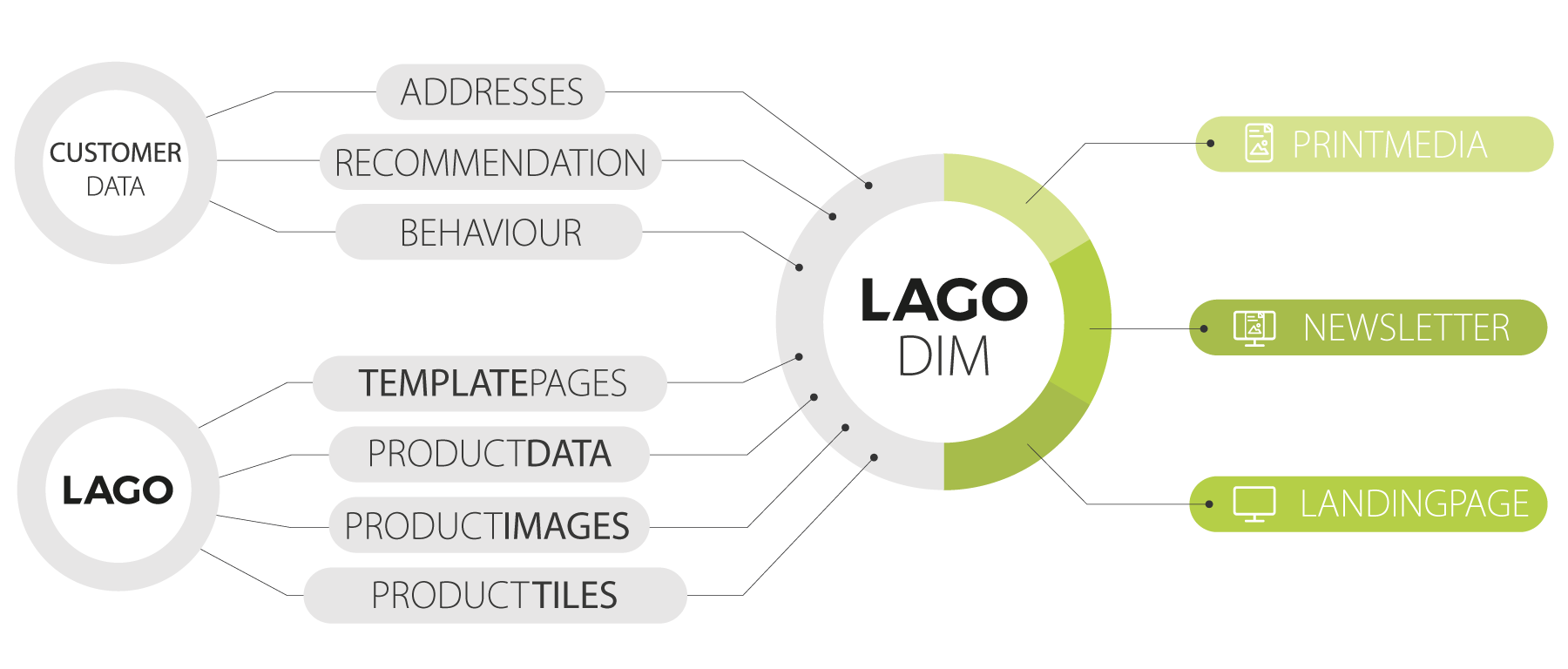
The Integration Challenge
No matter how well-designed a print or online campaign may be, the key to success will always be a retailer’s integration of complex data. Mobile shopping apps, in-store kiosks, and loyalty programs all rely on the same basic data as the lowly circular. If the basic data infrastructure is sound for print campaigns, it will give retailers a leg up when expanding their digital footprint.
Unfortunately, there is no out-of-the-box solution for creating a grocery retailer’s ideal data marketing system. There are simply too many variables. However, both vendors and major retailers are embracing the integration challenge. One prominent grocery chain recently re-vamped its data operation with the help of Comosoft specialists. “We integrated four robust systems into LAGO,” one senior IT executive remarked. “We were able to streamline marketing for produce and accelerate time to market across our regional and national brand’s print and digital platforms.” The chain was also able to streamline and reduce costs for both print and digital marketing campaigns. “Gone are the days of multiple deadline extensions,” he said.
Making the Connection
In the pre-digital, pre-industrial days, the local general store had just about anything a shopper might need. The owner also had a direct, personal relationship with individual customers, whose needs and preferences were known. Those days are gone, but the desire for an intimate, personal connection still remains. The grocery retailer who can make that connection, virtually and with the aid of well-integrated data, will succeed at making their brand a trusted destination.




